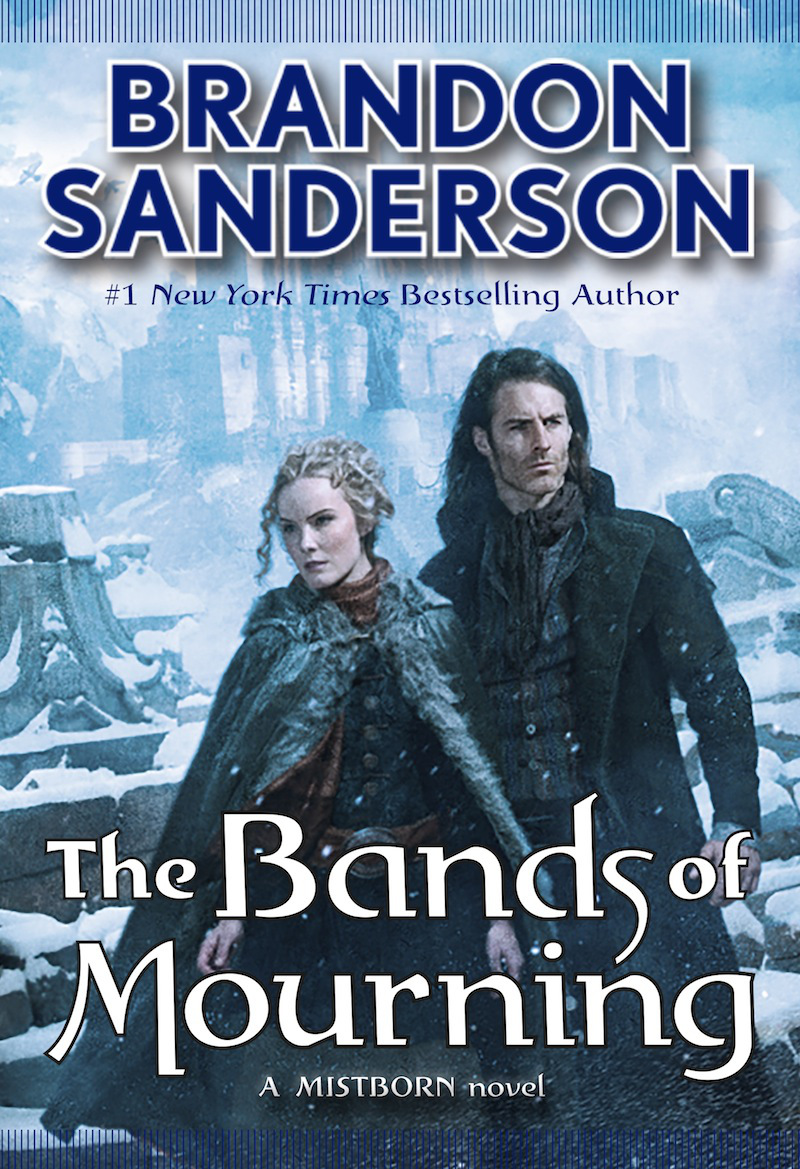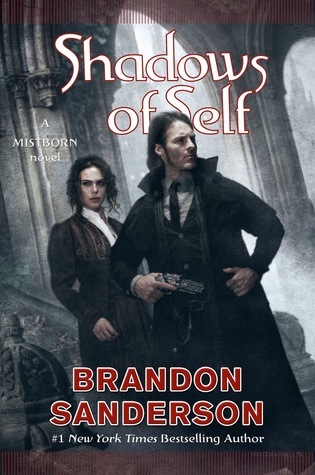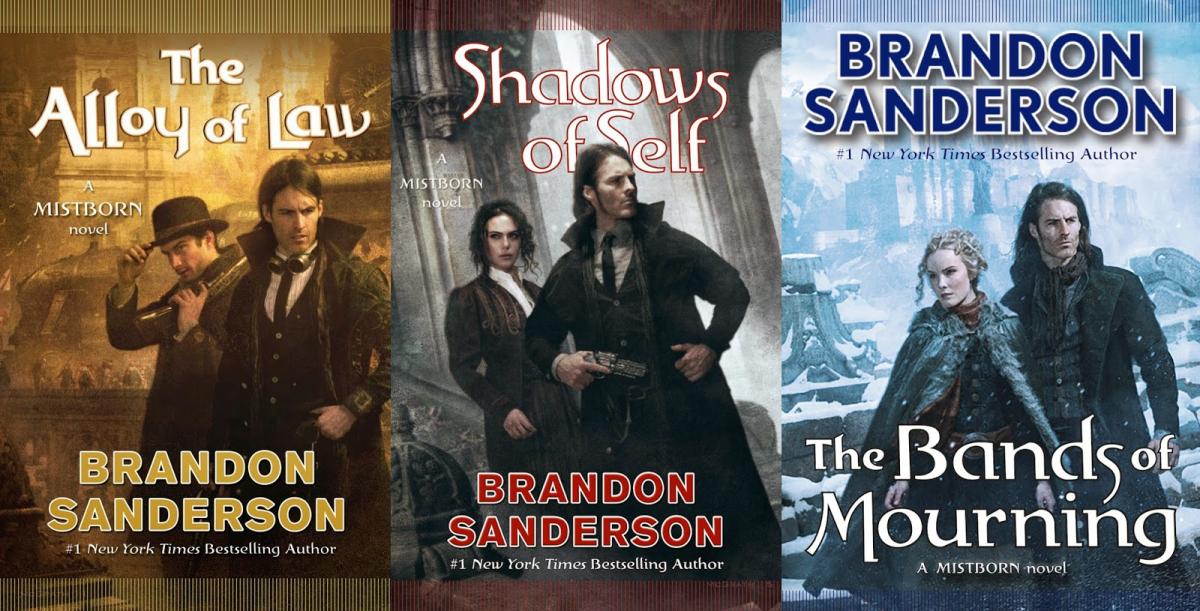It’s not easy being an wealthy, gifted, powerful scion of a noble house whose heroics have earned him the attention of God Itself. For one thing, if that God has played you false and used you, it’s exceptionally difficult to get away to mourn and heal. For another, you have certain responsibilities that don’t go away, especially not in a volatile political climate. And when God–even one who’s a bit of a jerk–makes a request of you, it’s not exactly easy to say no.
You can, of course, pretend that you’re going to let your admirers and associate do it for you. For about two seconds, fooling no one, but you can. You might even fool yourself–until a fight breaks out on a moving train. Then you’re well and truly in it, and you’re going to find out about the strange new technology, the rumored dangers both in and out beyond the edges of society, and the missing kandra who may have found the Lord Ruler’s lost bracers.

You being Waxillium Ladrian, of course.
Wax doesn’t have much personal interest in the mythical bracers, but he’s very interested in keeping them out of the hands of his uncle and his uncle’s murderous band of revolutionaries. Stopping the Set supersedes his desire to remain bitterly aloof from his religion, from his friends, and his world. And thank goodness, because this gem of a book is jam-packed with the kind of murder and mayhem only Sanderson can provide. And an awkward party. It wouldn’t be a Brandon Sanderson if someone didn’t ruin a snooty party.
There are all kinds of new Allomantic goodies to ratchet up the fight scenes and the mystery, and a bit more about the world outside of the city and the roughs. The country as a whole comes into sharper focus, as do the veins of discontent running through it that make the Set’s ascendance possible. Wax will have to put aside his anger and even his thirst for justice if he’s going to stop them. But that’s nothing compared to putting aside his loss of faith if he wants the mythical bands.
I wasn’t wholly convinced by the middle installment of this trilogy, Shadows of Self. It had its moments, and obviously Sanderson always brings it with the magic and the battles, but Sanderson was trying to turn a one-off (Alloy of Law) into a trilogy and the seams started to strain. Mostly I was lukewarm on the characters, who had to go from above-average heroes in crazy-powerful world to epic heroes far more powerful and intelligent than anyone around them. I’ve never been as keen on Wax and Wayne as I was on Vin and the whole crew. Wax is self-absorbed and tends to always be right, which makes his self-absorption all the more irritating. He also mopes about being restrained by high society, but other than tweaking his fellow lords, he doesn’t use his power for much more than his vanity projects–though those projects are, in fairness, fighting crime. He’s Batman without the insight of philanthropic Bruce Wayne, and without the charm of playboy Bruce Wayne.
All the charm is left to Wayne (not Bruce Wayne, just Wayne), who is genuinely funny most of the time, but can be a bit grating with his dopey cowpoke act. Wayne begins Bands of Mourning with some character evolution, which I heartily appreciated. His arc was much more satisfying than in Shadows, which shoehorned a scene of terrible sadness into an otherwise rather lackadaisical portrayal, and neither quite fit right. Bands hit grief and growth at much better points in the narrative and with much more emotional force, finally showing us Wayne’s complexity and depth.

Most of the social insight is left to Marsai, female constable, social historian, and statistician. She spent Shadows of Self pointing out the larger implications of Wax’s periodic gunfights, and generally trying to keep an entire city from imploding. The resolution of her storyline is marvelous, just some really fine character work from Sanderson, who has been getting better and better at making room in his high-octane works for these less explosive insights. Marsai has been well-fleshed from the beginning, but read to the end and you’ll find her really evolve in a way that might not be popular, but is certainly makes a good story even better.
By far my favorite character is Steris. Were she to exist in this would she would probably be diagnosed as somewhere on the autism spectrum, but in the Mistborn universe she’s an eccentric who is only spared being an outcast because of her wealth. She understands social interactions only by extensive research, and is more at home with forensic accounting than either needlepoint or gunslinging. She also makes lists of all the things that could possibly go wrong around Wax and Wayne–long lists, necessarily, but often still not comprehensive. They’re her way of being helpful to the others, a sweet sentiment that gradually becomes an essential tool.
I find her atypical non-romance with Wax to be one of the most interesting things about this trilogy. What begins as mutually advantageous marriage of convenience swiftly morphs into…well, something amorphous. Steris is often in need of rescue and oftener still becomes a Bystander with a capital B. Neither Allomancer nor Feruchemist nor even slightly familiar with violence, she has had the hardest job in this trilogy in some ways. She has to find a way to be useful to Wax, or at least not get under his feet, with no one to help her along, not even her intended. Wax comes off as callous in the second book when he doesn’t even bother to consider her most of the time, especially when it’s clear that she contorts herself trying to accommodate him. Mostly he’s amused by her, as he might be by an acquaintance or a pet. Heroes can be jerks, but this particular brand of jerkiness wasn’t acknowledged as such, which was a strange lapse in Sanderson’s usually rather moral universes. The third book corrected for that with some real insights about Steris, her relationship with Wax, and her relationships with the rest of the gang.
Ultimately, Bands of Mourning is a chimera, the fascinating but not altogether harmonious fusion of a story that probably should have been the second installment, not the third. I believe this is the final tale of Wax, Wayne, and Associates (though I am pleased to finally find that I hope I’m wrong), but there have been so many revelations that it feels a tad unfinished. Then again, the resolution between Wax and Steris, and the fate of the Bands, feels quite final. I know Sanderson didn’t originally intend to write the second and third books at all, and his usually meticulous planning must have been rushed. Shadows feels more like a a book he could have written to go back and fill in the details five or ten years after the fact; Bands is where the really good stuff is, plot-wise and character-wise. It’s so good, in fact, that it smooths over any rough edges from the previous two novels and leaves me with that familiar agony and eagerness that characterizes any period when I’m waiting for the next Brandon Sanderson novel. Read this and get used that that feeling. It–and Bands of Mourning–will stay with you.
Bands of Mourning comes out January 26th.

